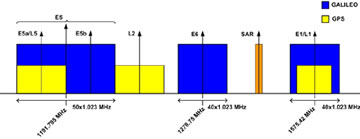Articles tagged with: Fantinato Samuele

E5 band (1164 -1215 MHz), composed of E5a and E5b bands, is part of the spectrum allocated by ITU for new Radio Navigation Satellite Services in 2000. E5 signal has the wider bandwidth (51.150 MHz) never used in satellite navigation. Galileo E5 signal is composed by two data components and two pilot components broadcasted together by means of the multiplexing scheme AltBOC(15,10). E5a band will be used for Freely/NAV message (Open Service) and the codes of data and pilot components are uncripted, E5b band will be used for Integrity/NAV message for Safety of Life and Open Service. Integrity of signal is probably the most advanced service introduced by Galileo [1]. One of the main feature of E5 band is that the signal can be received in two ways: the first is to filter and demodulate only one of side bands E5a or E5b (see Fig. 1) the second is to process the overall received signal containing the components of both bands [2],[3]. In this sections is considered the second way because it will be adopted by professional receivers and this will avoid to obtain all the advantages of Galileo signal. E5 is the most promising signal in terms of performance in multipath environment and positioning for critical applications but also the most challenging for a receiver or a simulation. In this paper will be presented the simulation of the transmission and reception of E5 signal. It will be first described the generation of codes, then it will be illustrated Galileo AltBOC(15,10) signal structure and its differences with a conventional AltBOC, it will be shown a way for the generation of that signal and some basic characteristics for the development of a software receiver for E5.










 (5.00 out of 5)
(5.00 out of 5)